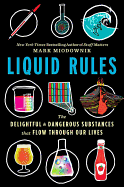
For most people, a transatlantic flight is an opportunity to read a book, nap the time away, anxiously endure every bit of turbulence or wonder about the stranger sitting next to you. For materials scientist and engineer Mark Miodownik, it's an opportunity to consider the myriad roles liquids play on an aircraft, and beyond.
In his first book, Stuff Matters, Miodownik gave readers a tour of "dependable solid stuff." In Liquid Rules, he examines fluids, which, when not contained, are "seeping, corroding, dripping, and escaping our control." Kerosene's ability to be burned in a controlled manner not only revolutionized indoor lighting, but also enabled fuel for air travel. Miodownik soberly discusses how the explosive power of engine fuel caused the Twin Towers to collapse on 9/11.
While filling out a customs form with the humble ballpoint pen, he considers ink. While permanence is its greatest asset, efficiently controlling the flow of a substance that dries quickly took hundreds of years to perfect. Stickiness--not a property of liquid, but rather how it interacts with a specific material--explains how adhesives work and hold modern planes together. And, no less important, Miodownik describes the commonplace, such as how surface tension reveals the level of alcohol in a glass of wine, and how to enjoy the perfect cup of tea.
Liquids give us life, but they can also compromise it. The revolution in refrigeration led to chlorofluorocarbons (CFCs) that, when discarded, damage the atmosphere. And Miodownik looks beyond the plane to consider the destructive force of tsunamis and the impact of our water footprint. With this amiable delivery system, the science of liquid is anything but dry. --Frank Brasile, librarian

